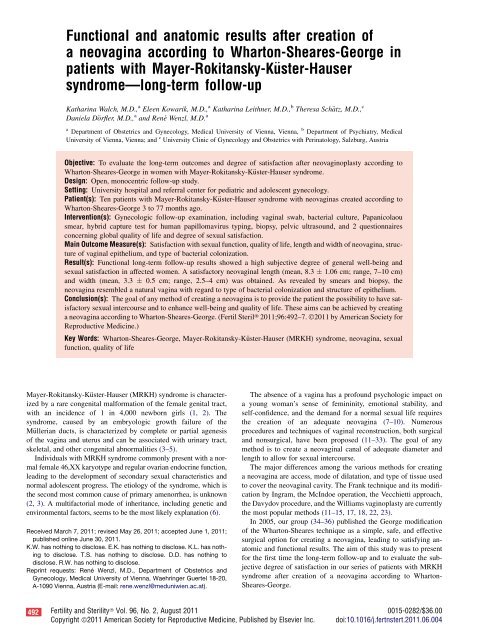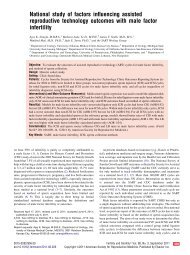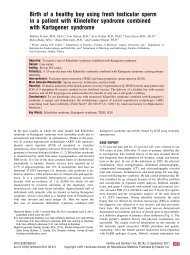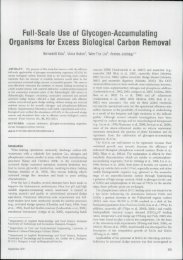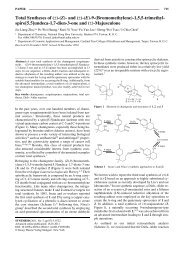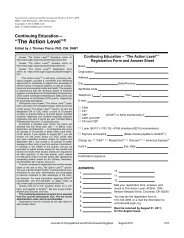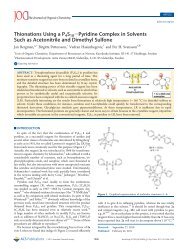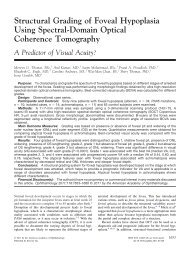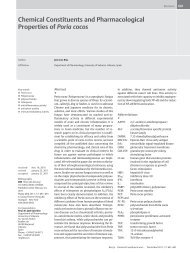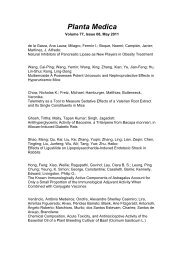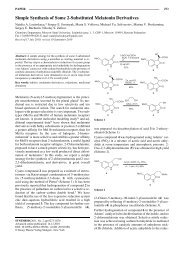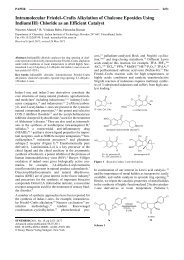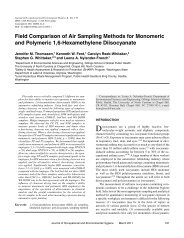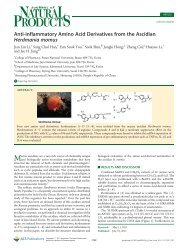Functional and anatomic results after creation of a neovagina ...
Functional and anatomic results after creation of a neovagina ...
Functional and anatomic results after creation of a neovagina ...
Create successful ePaper yourself
Turn your PDF publications into a flip-book with our unique Google optimized e-Paper software.
<strong>Functional</strong> <strong>and</strong> <strong>anatomic</strong> <strong>results</strong> <strong>after</strong> <strong>creation</strong> <strong>of</strong><br />
a <strong>neovagina</strong> according to Wharton-Sheares-George in<br />
patients with Mayer-Rokitansky-K€uster-Hauser<br />
syndrome—long-term follow-up<br />
Katharina Walch, M.D., a Eleen Kowarik, M.D., a Katharina Leithner, M.D., b Theresa Sch€atz, M.D., c<br />
Daniela D€orfler, M.D., a <strong>and</strong> Rene Wenzl, M.D. a<br />
a Department <strong>of</strong> Obstetrics <strong>and</strong> Gynecology, Medical University <strong>of</strong> Vienna, Vienna, b Department <strong>of</strong> Psychiatry, Medical<br />
University <strong>of</strong> Vienna, Vienna; <strong>and</strong> c University Clinic <strong>of</strong> Gynecology <strong>and</strong> Obstetrics with Perinatology, Salzburg, Austria<br />
Objective: To evaluate the long-term outcomes <strong>and</strong> degree <strong>of</strong> satisfaction <strong>after</strong> neovaginoplasty according to<br />
Wharton-Sheares-George in women with Mayer-Rokitansky-K€uster-Hauser syndrome.<br />
Design: Open, monocentric follow-up study.<br />
Setting: University hospital <strong>and</strong> referral center for pediatric <strong>and</strong> adolescent gynecology.<br />
Patient(s): Ten patients with Mayer-Rokitansky-K€uster-Hauser syndrome with <strong>neovagina</strong>s created according to<br />
Wharton-Sheares-George 3 to 77 months ago.<br />
Intervention(s): Gynecologic follow-up examination, including vaginal swab, bacterial culture, Papanicolaou<br />
smear, hybrid capture test for human papillomavirus typing, biopsy, pelvic ultrasound, <strong>and</strong> 2 questionnaires<br />
concerning global quality <strong>of</strong> life <strong>and</strong> degree <strong>of</strong> sexual satisfaction.<br />
Main Outcome Measure(s): Satisfaction with sexual function, quality <strong>of</strong> life, length <strong>and</strong> width <strong>of</strong> <strong>neovagina</strong>, structure<br />
<strong>of</strong> vaginal epithelium, <strong>and</strong> type <strong>of</strong> bacterial colonization.<br />
Result(s): <strong>Functional</strong> long-term follow-up <strong>results</strong> showed a high subjective degree <strong>of</strong> general well-being <strong>and</strong><br />
sexual satisfaction in affected women. A satisfactory <strong>neovagina</strong>l length (mean, 8.3 1.06 cm; range, 7–10 cm)<br />
<strong>and</strong> width (mean, 3.3 0.5 cm; range, 2.5–4 cm) was obtained. As revealed by smears <strong>and</strong> biopsy, the<br />
<strong>neovagina</strong> resembled a natural vagina with regard to type <strong>of</strong> bacterial colonization <strong>and</strong> structure <strong>of</strong> epithelium.<br />
Conclusion(s): The goal <strong>of</strong> any method <strong>of</strong> creating a <strong>neovagina</strong> is to provide the patient the possibility to have satisfactory<br />
sexual intercourse <strong>and</strong> to enhance well-being <strong>and</strong> quality <strong>of</strong> life. These aims can be achieved by creating<br />
a <strong>neovagina</strong> according to Wharton-Sheares-George. (Fertil SterilÒ 2011;96:492–7. Ó2011 by American Society for<br />
Reproductive Medicine.)<br />
Key Words: Wharton-Sheares-George, Mayer-Rokitansky-K€uster-Hauser (MRKH) syndrome, <strong>neovagina</strong>, sexual<br />
function, quality <strong>of</strong> life<br />
Mayer-Rokitansky-K€uster-Hauser (MRKH) syndrome is characterized<br />
by a rare congenital malformation <strong>of</strong> the female genital tract,<br />
with an incidence <strong>of</strong> 1 in 4,000 newborn girls (1, 2). The<br />
syndrome, caused by an embryologic growth failure <strong>of</strong> the<br />
M€ullerian ducts, is characterized by complete or partial agenesis<br />
<strong>of</strong> the vagina <strong>and</strong> uterus <strong>and</strong> can be associated with urinary tract,<br />
skeletal, <strong>and</strong> other congenital abnormalities (3–5).<br />
Individuals with MRKH syndrome commonly present with a normal<br />
female 46,XX karyotype <strong>and</strong> regular ovarian endocrine function,<br />
leading to the development <strong>of</strong> secondary sexual characteristics <strong>and</strong><br />
normal adolescent progress. The etiology <strong>of</strong> the syndrome, which is<br />
the second most common cause <strong>of</strong> primary amenorrhea, is unknown<br />
(2, 3). A multifactorial mode <strong>of</strong> inheritance, including genetic <strong>and</strong><br />
environmental factors, seems to be the most likely explanation (6).<br />
Received March 7, 2011; revised May 26, 2011; accepted June 1, 2011;<br />
published online June 30, 2011.<br />
K.W. has nothing to disclose. E.K. has nothing to disclose. K.L. has nothing<br />
to disclose. T.S. has nothing to disclose. D.D. has nothing to<br />
disclose. R.W. has nothing to disclose.<br />
Reprint requests: Rene Wenzl, M.D., Department <strong>of</strong> Obstetrics <strong>and</strong><br />
Gynecology, Medical University <strong>of</strong> Vienna, Waehringer Guertel 18-20,<br />
A-1090 Vienna, Austria (E-mail: rene.wenzl@meduniwien.ac.at).<br />
492<br />
The absence <strong>of</strong> a vagina has a pr<strong>of</strong>ound psychologic impact on<br />
a young woman’s sense <strong>of</strong> femininity, emotional stability, <strong>and</strong><br />
self-confidence, <strong>and</strong> the dem<strong>and</strong> for a normal sexual life requires<br />
the <strong>creation</strong> <strong>of</strong> an adequate <strong>neovagina</strong> (7–10). Numerous<br />
procedures <strong>and</strong> techniques <strong>of</strong> vaginal reconstruction, both surgical<br />
<strong>and</strong> nonsurgical, have been proposed (11–33). The goal <strong>of</strong> any<br />
method is to create a <strong>neovagina</strong>l canal <strong>of</strong> adequate diameter <strong>and</strong><br />
length to allow for sexual intercourse.<br />
The major differences among the various methods for creating<br />
a <strong>neovagina</strong> are access, mode <strong>of</strong> dilatation, <strong>and</strong> type <strong>of</strong> tissue used<br />
to cover the <strong>neovagina</strong>l cavity. The Frank technique <strong>and</strong> its modification<br />
by Ingram, the McIndoe operation, the Vecchietti approach,<br />
the Davydov procedure, <strong>and</strong> the Williams vaginoplasty are currently<br />
the most popular methods (11–15, 17, 18, 22, 23).<br />
In 2005, our group (34–36) published the George modification<br />
<strong>of</strong> the Wharton-Sheares technique as a simple, safe, <strong>and</strong> effective<br />
surgical option for creating a <strong>neovagina</strong>, leading to satisfying <strong>anatomic</strong><br />
<strong>and</strong> functional <strong>results</strong>. The aim <strong>of</strong> this study was to present<br />
for the first time the long-term follow-up <strong>and</strong> to evaluate the subjective<br />
degree <strong>of</strong> satisfaction in our series <strong>of</strong> patients with MRKH<br />
syndrome <strong>after</strong> <strong>creation</strong> <strong>of</strong> a <strong>neovagina</strong> according to Wharton-<br />
Sheares-George.<br />
Fertility <strong>and</strong> Sterility â Vol. 96, No. 2, August 2011 0015-0282/$36.00<br />
Copyright ª2011 American Society for Reproductive Medicine, Published by Elsevier Inc. doi:10.1016/j.fertnstert.2011.06.004
MATERIALS AND METHODS<br />
Between June 2001 <strong>and</strong> September 2009, 17 consecutive young women with<br />
MRKH syndrome were surgically treated with neovaginoplasty according to<br />
the Wharton-Sheares-George technique at the Department <strong>of</strong> Obstetrics <strong>and</strong><br />
Gynecology, Medical University <strong>of</strong> Vienna, Austria. All operations were<br />
performed by the same gynecologist (R.W.).<br />
All women underwent an extensive preoperative diagnostic workup, including<br />
an intravenous pyelography to detect anomalies <strong>of</strong> the urinary tract.<br />
The surgical procedure is described in detail by Sch€atz et al. (36). After local<br />
pretreatment with estriol cream for 3 weeks, a diagnostic laparoscopy was<br />
performed under general anesthesia for orientation <strong>and</strong> confirmation <strong>of</strong> the<br />
abdominal organs. Afterward, the rudimentary M€ullerian ducts (which could<br />
be identified in all patients, 2 cm dorsal to the external urethral ostium <strong>and</strong> 1<br />
cm paramedially) were dilated incrementally by gently pushing Hegar dilatators<br />
(2.5–14) in the direction <strong>of</strong> the pelvic axis (Fig. 1). The median raphe<br />
was intersected with diathermy, <strong>and</strong> subsequently, a vaginal mold, coated<br />
with estriol, was inserted into the newly created cavity. On the seventh<br />
day, the vaginal mold was exchanged for a larger one. Based on our experience<br />
as well as recommendations in the literature (16, 19, 30), patients were<br />
advised to continue using the plastic mold for the first 3 postoperative<br />
months, day <strong>and</strong> night, to prevent stenosis <strong>and</strong> shrinking <strong>of</strong> the <strong>neovagina</strong>.<br />
After this period, normal sexual intercourse was possible.<br />
All patients with MRKH syndrome who had been treated surgically according<br />
to the Wharton-Sheares-George technique at the Department <strong>of</strong> Obstetrics<br />
<strong>and</strong> Gynecology, Medical University <strong>of</strong> Vienna, Austria (n ¼ 17),<br />
were invited for a follow-up evaluation, conducted from September 2009<br />
to February 2010. Three women were excluded from the study because <strong>of</strong><br />
a follow-up time <strong>of</strong> less than 3 months. Three patients were lost to followup<br />
because <strong>of</strong> changes in their addresses <strong>and</strong> cell phone numbers, <strong>and</strong> 1<br />
woman refused to return because <strong>of</strong> a new job a greater distance away. Therefore,<br />
10 patients could be included in this open study evaluating the longterm<br />
functional <strong>and</strong> <strong>anatomic</strong> success <strong>of</strong> the operation.<br />
Institutional Review Board approval was obtained for the study, <strong>and</strong><br />
women gave their verbal <strong>and</strong> written informed consent before inclusion.<br />
All procedures were performed in accordance with the st<strong>and</strong>ards <strong>of</strong> the responsible<br />
ethics committee.<br />
At the follow-up visit, participants underwent a gynecologic examination,<br />
including palpation, pelvic ultrasound, vaginal swab, bacterial culture, Papanicolaou<br />
(PAP) smear, hybrid capture test for human papillomavirus (HPV)<br />
typing, <strong>and</strong> biopsy. Afterward, women were asked to grade the severity <strong>of</strong><br />
pain during the examination on a 100-mm visual analogue scale (VAS). Individual<br />
quality <strong>of</strong> psychosexual life <strong>and</strong> overall subjective degree <strong>of</strong> satisfaction<br />
with the operation were assessed by 2 specific questionnaires.<br />
The Rosen Female Sexual Function Index (FSFI) questionnaire, validated<br />
for the German-speaking population, contains 19 st<strong>and</strong>ardized questions for<br />
the evaluation <strong>of</strong> female sexual quality <strong>of</strong> function (i.e., desire, arousal, orgasmic<br />
<strong>and</strong> sexual pain disorder, quality <strong>of</strong> vaginal lubrication, <strong>and</strong> global<br />
sexual <strong>and</strong> relationship satisfaction) (37). Women were also asked to fill<br />
out a second questionnaire created by our group containing 23 specific questions<br />
to elucidate the individual medical history <strong>and</strong> current situation <strong>of</strong> the<br />
patients (e.g., influence <strong>of</strong> the diagnosis <strong>and</strong> surgical treatment on selfesteem,<br />
sexual life, <strong>and</strong> relationships). Well-being scores before surgery<br />
compared with the present time were recorded at the follow-up examination.<br />
The main outcome measure <strong>of</strong> the present study was the functional (satisfaction<br />
with sexual parameters <strong>and</strong> quality <strong>of</strong> life), long-term result <strong>of</strong> the<br />
surgical procedure. In addition, we evaluated the <strong>anatomic</strong> (length <strong>and</strong> width<br />
<strong>of</strong> the <strong>neovagina</strong>, structure <strong>of</strong> the vaginal epithelium, <strong>and</strong> type <strong>of</strong> bacterial<br />
colonization) outcome.<br />
RESULTS<br />
At the time <strong>of</strong> the neovaginoplasty according to Wharton-Sheares-<br />
George, the mean age <strong>of</strong> the patients was 20.0 5.8 years (range,<br />
15–34 years). Mean follow-up since the operation was 33.5<br />
22.4 months (range, 3–77 months).<br />
All operations had been performed without major complications.<br />
In 6 patients, minor old blood secretions were found during the<br />
Fertility <strong>and</strong> Sterility â<br />
FIGURE 1<br />
Vaginal dimple—rudimentary M€ullerian ducts. Hegar is pointing to<br />
the left M€ullerian duct.<br />
Walch. Long-term outcomes <strong>after</strong> Wharton-Sheares-George surgery. Fertil Steril 2011.<br />
exchange <strong>of</strong> the vaginal mold on the seventh postoperative day. In<br />
1 patient, elevated body temperature occurred postoperatively concomitant<br />
with fluid retention in the <strong>neovagina</strong>l region but was<br />
treated effectively with antibiotics; no surgical intervention was<br />
needed. Eight patients reported mild abdominal pain during the first<br />
postoperative days; analgesic medication was administered. Mean<br />
operation time, including diagnostic laparoscopy (additional adhesiolysis<br />
in 1 patient <strong>and</strong> tubectomy in another), was 46 9 minutes<br />
(range, 30–65 minutes). The mean time for Wharton-Sheares-<br />
George dilation was 21.5 2 minutes (range, 20–25 minutes).<br />
Four <strong>of</strong> the 10 patients (40%) presented with congenital inguinal<br />
hernia in their medical history. In all <strong>of</strong> these patients, surgical treatment<br />
had been performed successfully in the past. In one <strong>of</strong> the patients,<br />
multiple skeletal anomalies (Morbus Sprengel) <strong>and</strong> a throat<br />
fistula had also been found. Another patient demonstrated a pelvic<br />
kidney on the left side.<br />
At the follow-up investigation, the external genitals were regular<br />
in all patients, <strong>and</strong> no prolapse <strong>of</strong> the <strong>neovagina</strong> had occurred postoperatively<br />
in any <strong>of</strong> the patients. A gynecologic examination with 2<br />
st<strong>and</strong>ard specula (Breisky anterior speculum, 100 25; Matzenauer<br />
posterior speculum, 100 25 mm; KLS Martin Group) could be<br />
performed in every patient. The mean score for severity <strong>of</strong> pain during<br />
the examination was 12 11 (range, 0–30; no pain at all, 0 <strong>and</strong><br />
maximum, 100).<br />
In 9 <strong>of</strong> 10 patients, the <strong>neovagina</strong> appeared macroscopically<br />
regular; in 1 patient, the process <strong>of</strong> epithelialization was not yet<br />
complete because the time since the operation was relatively short<br />
(
TABLE 1<br />
Gynecologic examination <strong>and</strong> questionnaire findings for the overall degree <strong>of</strong> satisfaction with the result <strong>of</strong> the operation, sex life,<br />
<strong>and</strong> diameter <strong>of</strong> the <strong>neovagina</strong>.<br />
Patient 1 2 3 4 5 6 7 8 9 10 Mean ± SD<br />
Length <strong>of</strong> <strong>neovagina</strong> (cm) 8 10 8 7 7 10 8 8 8 9 8.3 ( 1,06)<br />
Width <strong>of</strong> <strong>neovagina</strong> (cm) 3 4 3 3 2.5 4 3.5 3.5 3 3 3.3 ( 0,5)<br />
Satisfaction with sex life (VAS<br />
100–0; 100, very satisfied; 0,<br />
not satisfied)<br />
82 100 27 86 53 50 100 100 100 99 79.7 ( 26.7)<br />
Pain during sexual intercourse<br />
(VAS 0-100; 0, no pain at all;<br />
100, maximum pain)<br />
31 0 N/A a<br />
33 N/A a<br />
N/A a<br />
0 0 65 0<br />
Satisfaction with <strong>results</strong> <strong>of</strong> the<br />
operation (VAS,<br />
100-0, 100: very satisfied 0:<br />
not satisfied)<br />
100 99 98 99 97 92 100 100 93 98 97.6 ( 2.9)<br />
Would you choose this<br />
surgical technique again?<br />
yes yes yes yes yes yes yes yes probably not yes<br />
a Not applicable because patients 3, 5, <strong>and</strong> 6 did not have sexual intercourse at the time <strong>of</strong> follow-up.<br />
Walch. Long-term outcomes <strong>after</strong> Wharton-Sheares-George surgery. Fertil Steril 2011.<br />
Nine <strong>of</strong> 10 patients would definitively choose this surgical technique<br />
again; 1 woman was undecided. The mean well-being scores<br />
before <strong>and</strong> <strong>after</strong> the operation, using a 100-point VAS (perfect wellbeing,<br />
100), were 52.7 20.5 <strong>and</strong> 87.8 15.2, respectively (Fig. 2).<br />
FIGURE 2<br />
The average increase in mean well-being was 35.1 27.4 <strong>and</strong> was<br />
statistically significant (P¼.003). Nine <strong>of</strong> the 10 patients mentioned<br />
that their self-esteem had improved markedly as a consequence <strong>of</strong><br />
the operation.<br />
Comparison between well-being scores before the <strong>creation</strong> <strong>of</strong> a <strong>neovagina</strong> according to Wharton-Sheares-George <strong>and</strong> at the time <strong>of</strong> the<br />
follow-up investigation.<br />
Walch. Long-term outcomes <strong>after</strong> Wharton-Sheares-George surgery. Fertil Steril 2011.<br />
494 Walch et al. Long-term outcomes <strong>after</strong> Wharton-Sheares-George surgery Vol. 96, No. 2, August 2011
TABLE 2<br />
Female Sexual Function Index values for the 7 sexually active patients with MRKH <strong>after</strong> Wharton-Sheares-George surgery, compared with equivalent mean FSFI values for<br />
patients with MRKH syndrome <strong>after</strong> alternative surgical techniques <strong>and</strong> for healthy individuals.<br />
Laparoscopic<br />
modified<br />
Vecchietti<br />
technique<br />
(n [ 27)<br />
Fertility <strong>and</strong> Sterility â<br />
Healthy<br />
women<br />
(n [ 131)<br />
Laparoscopic<br />
Vecchietti<br />
technique<br />
(n [ 40)<br />
Laparoscopic<br />
Davydov<br />
technique<br />
(n [ 6)<br />
Laparoscopic<br />
Davydov<br />
technique<br />
(n [ 40)<br />
Davydov<br />
laparoscopic<br />
vaginoplasty<br />
(n [ 25)<br />
Sigmoid<br />
vaginoplasty<br />
(n [ 11)<br />
Amnion<br />
vaginoplasty<br />
(n [ 5)<br />
Wharton-<br />
Sheares-George<br />
surgery (n [ 7)<br />
Desire 4.3 1.3 4.9 1.2 4.7 0.9 4.4 0.9 4.3 0.7 3.9 1.2 4.4 0.8 4.2 0.9 4.1 1.1<br />
Arousability 5.4 0.5 5.0 0.8 4.9 0.6 4.4 1.1 4.7 0.8 4.0 1.1 4.8 0.8 4.6 1.0 5.0 1.0<br />
Lubrication 5.1 1.5 4.0 0.7 5.0 0.9 4.5 1.4 5.1 0.6 4.4 1.0 5.0 0.8 4.5 1.0 5.5 0.9<br />
Orgasm 4.9 1.0 5.5 1.0 5.3 0.8 4.1 1.3 5.0 0.6 3.3 1.6 4.6 1.0 4.4 0.9 5.0 1.2<br />
Satisfaction 5.1 1.5 5.3 1.4 4.7 1.6 4.6 1.1 4.8 1.5 4.0 1.8 5.4 0.6 5.2 1.2 5.1 1.2<br />
Pain 5.1 1.1 5.3 1.8 3.5 2.4 4.4 1.4 4.7 1.0 1.9 1.9 5.0 0.9 5.2 1.0 5.5 1.0<br />
Total score 29.9 4.3 30.0 6.9 28.0 5.0 26.5 5.6 31.8 0.8 21.4 5.3 29.0 3.2 30.2 1.0 30.2 6.1<br />
Reference 16 20 38 17 27 18 17 37<br />
Note: Values are given as means SD. Patients without sexual activity within the past month were not included in this FSFI evaluation. Total FSFI score ranges from 0 to 36.<br />
Walch. Long-term outcomes <strong>after</strong> Wharton-Sheares-George surgery. Fertil Steril 2011.<br />
Seven <strong>of</strong> the 10 examined patients had had repeated sexual intercourse<br />
(defined as intercourse at least 2 times per month) since the<br />
operation, <strong>and</strong> 5 <strong>of</strong> these 7 women were able to experience orgasm.<br />
The mean average frequency <strong>of</strong> intercourse in the 7 sexually active<br />
women was 10.14 9 times per month. At the time <strong>of</strong> follow-up, 5<br />
<strong>of</strong> 10 patients had a partner <strong>and</strong> 1 <strong>of</strong> them was married. Three<br />
women had no regular sexual intercourse because they had no<br />
partner.<br />
A detailed analysis <strong>of</strong> the FSFI scores in our group, compared<br />
with those <strong>of</strong> other common surgical techniques for creating a <strong>neovagina</strong>,<br />
<strong>and</strong> in relation to healthy women with a natural vagina<br />
(control female population), is presented in Table 2 (16–18, 20,<br />
27, 37, 38).<br />
Neovaginal smears showed a remarkable resemblance to those<br />
from normal vaginal epithelium: the presence <strong>of</strong> D€oderlein bacilli<br />
could be detected in 80%. None <strong>of</strong> the women had used D€oderlein<br />
vaginal tablets within 3 months before the follow-up investigation.<br />
Gardnerella vaginalis (4 <strong>of</strong> 10) <strong>and</strong> HPV infection (low-grade squamous<br />
intraepithelial lesions) (1 patient) were also observed.<br />
In 8 women, we successfully obtained a biopsy <strong>of</strong> the epithelialized<br />
<strong>neovagina</strong>; in all patients, the biopsy showed nonkeratinizing<br />
stratified squamous epithelium (Supplemental Fig. 1, available online).<br />
One women refused the biopsy because she worried about<br />
the pain. In another case, the biopsy did not contain enough tissue<br />
material to allow for histologic diagnosis. In both <strong>of</strong> these patients,<br />
the <strong>neovagina</strong> appeared macroscopically regular.<br />
DISCUSSION<br />
Management <strong>of</strong> patients with MRKH syndrome includes, along with<br />
proper psychologic support, the <strong>creation</strong> <strong>of</strong> a <strong>neovagina</strong> to give affected<br />
women the opportunity to have a normal sexual life. Various<br />
treatment options are available (11–36), including nonoperative<br />
methods such as progressive dilatation (11, 12); numerous surgical<br />
techniques such as skin grafts (13, 28, 35), fasciocutaneous flaps<br />
(26), buccal mucosa (30), amnion (16), peritoneal (19, 23),<br />
intestinal (20, 21, 24), <strong>and</strong> vesical transplants (31); <strong>and</strong> epithelialization<br />
from the outer skin layer (22, 25, 36). There is, however, no<br />
consensus about which procedure should be considered the ideal<br />
strategy.<br />
Surgical treatment options must be functional, minimally invasive,<br />
quick, simple, reliable, safe, <strong>and</strong> cost effective (39–41).<br />
The neovaginoplasty according to Wharton-Sheares-George seems<br />
to meet these criteria <strong>and</strong> represents an operative method <strong>of</strong> creating<br />
a functional vagina with high success rates, without most <strong>of</strong> the<br />
attendant disadvantages <strong>and</strong> complications <strong>of</strong> traditional procedures<br />
(36).<br />
For the <strong>creation</strong> <strong>of</strong> a <strong>neovagina</strong> according to Wharton-Sheares-<br />
George, laparotomy, application <strong>of</strong> a traction device (as in the<br />
Vecchietti approach, still the most commonly used procedure in European<br />
countries, which can be associated with remarkable discomfort<br />
<strong>and</strong> potential serious complications such as urinary stress<br />
incontinence <strong>and</strong> injuries to neighboring organs), or pressure to<br />
the peritoneum is not needed; the trauma is limited to the area <strong>of</strong><br />
the <strong>neovagina</strong> (in contrast to intestinal vaginoplasty <strong>and</strong> the Davydov<br />
procedure), <strong>and</strong> the anatomy <strong>of</strong> the intrapelvic structures are unaltered<br />
(17, 18, 36). Therefore, postoperative pain <strong>and</strong> discomfort<br />
can be kept to a minimum. Another advantage <strong>of</strong> this surgical<br />
technique is the fact that the functional axis <strong>of</strong> the <strong>neovagina</strong> is<br />
identical to the <strong>anatomic</strong> axis <strong>of</strong> the ‘‘natural’’ vagina, allowing<br />
for satisfactory sexual intercourse.<br />
495
According to our data, the Wharton-Sheares-George technique<br />
provides functionally <strong>and</strong> <strong>anatomic</strong>ally very satisfactory <strong>results</strong>. In<br />
all 10 patients with follow-up, <strong>neovagina</strong>s were at least 2 fingers<br />
in width <strong>and</strong> 7 to 10 cm in length; were pink, clean, moist, <strong>and</strong> exp<strong>and</strong>able;<br />
<strong>and</strong> provided satisfactory sexual function, as assessed by<br />
high scores on the FSFI questionnaire, comparable with those <strong>of</strong><br />
controls. We compared recently published FSFI scores for the<br />
most popular surgical techniques (Table 2), which revealed that similarly<br />
good <strong>results</strong> could be achieved regardless <strong>of</strong> the method used,<br />
indicating that the simplest procedure associated with minimal<br />
complications should be favored.<br />
The <strong>neovagina</strong>, created by the Wharton-Sheares-George technique,<br />
is very similar in its macroscopic appearance <strong>and</strong> its microscopic<br />
structure to the normal vagina. The observation that in the<br />
woman with a relatively short follow-up time <strong>of</strong> less than 4 months,<br />
the process <strong>of</strong> epithelialization was not entirely complete at the cranial<br />
end <strong>of</strong> the <strong>neovagina</strong>l vault leads to the assumption that the ingrowth<br />
<strong>of</strong> epithelial cells starts from the vulvar region <strong>and</strong> proceeds<br />
in the cranial direction. The nonkeratinizing, stratified squamous epithelium<br />
seems to migrate from the edges <strong>of</strong> the <strong>neovagina</strong> inward or<br />
—alternatively—might arise from pluripotent stem cells located in<br />
the obliterated M€ullerian ducts.<br />
In this method, we do not require allogenic transplants, autologous<br />
transplants, or pluripotent stem cells, all recently reported as<br />
new <strong>and</strong> promising tissue engineering techniques in the animal<br />
model (42, 43). One should be aware that all <strong>of</strong> these procedures<br />
carry characteristic complications <strong>and</strong> potential risks (e.g., failure<br />
to grow; bleeding; infection; necrosis; rejection; shrinking <strong>of</strong> the<br />
graft, possibly associated with <strong>neovagina</strong>l stenosis <strong>and</strong><br />
dyspareunia; <strong>and</strong> a broad visible scar at the graft donor site).<br />
REFERENCES<br />
1. Rokitansky K. €Uber die sogenannte verdopplung des<br />
uterus. Med Jahrb €Osterr Staat 1838;26:39–42.<br />
2. ACOG Committee on Adolescent Health Care.<br />
ACOG Committee Opinion No. 355: vaginal agenesis:<br />
diagnosis, management, <strong>and</strong> routine care. Obstet<br />
Gynecol 2006;108:1605–9.<br />
3. Oppelt P, Renner SP, Kellermann A, Bruckner S,<br />
Hauser GA, Ludwig KS, et al. Clinical aspects <strong>of</strong><br />
Mayer-Rokitansky-Kuester-Hauser syndrome: recommendations<br />
for clinical diagnosis <strong>and</strong> staging.<br />
Hum Reprod 2006;21:792–7.<br />
4. Basile C, De Michele V. Renal abnormalities in<br />
Mayer-Rokitansky-K€uster-Hauser syndrome. J<br />
Nephrol 2001;14:316–8.<br />
5. Ganie MA, Laway BA, Ahmed S, Alai MS, Lone GN.<br />
Mayer-Rokitansky-K€uster-Hauser syndrome associated<br />
with atrial septal defect, partial anomalous pulmonary<br />
venous connection <strong>and</strong> unilateral kidney: an<br />
unusual triad <strong>of</strong> anomalies. J Pediatr Endocrinol<br />
Metab 2010;23:1087–91.<br />
6. Sultan C, Biason-Lauber A, Philibert P. Mayer-Rokitansky-K€uster-Hauser<br />
syndrome: recent clinical<br />
<strong>and</strong> genetic findings. Gynecol Endocrinol<br />
2009;25:8–11.<br />
7. Bean EJ, Mazur T, Robinson AD. Mayer-Rokitansky-<br />
K€uster-Hauser syndrome: sexuality, psychological<br />
effects, <strong>and</strong> quality <strong>of</strong> life. J Pediatr Adolesc Gynecol<br />
2009;22:339–46.<br />
8. Heller-Boersma JG, Schmidt UH, Edmends DK. Psychological<br />
distress in women with uterovaginal agenesis<br />
(Mayer-Rokitansky-K€uster-Hauser syndrome,<br />
MRKH). Psychosomtasics 2009;50:277–81.<br />
9. Laggari V, Diareme S, Christogiorgos S,<br />
Deligeoroglou E, Christopoulos P, Tsiantis J, et al.<br />
Anxiety <strong>and</strong> depression in adolescents with polycystic<br />
ovary syndrome <strong>and</strong> Mayer-Rokitansky-K€uster-Hauser<br />
syndrome. J Psychosom Obstet Gynaecol 2009;30:83–8.<br />
10. Langer M, Gr€unberger W, Ringler M. Vaginal agenesis<br />
<strong>and</strong> congenital adrenal hyperplasia. Psychological<br />
sequelae <strong>of</strong> diagnosis <strong>and</strong> <strong>neovagina</strong> formation. Acta<br />
Obstet Gynecol Sc<strong>and</strong> 1990;69:343–9.<br />
11. Frank RT. The formation <strong>of</strong> an artificial vagina without<br />
operation. Am J Obstet Gynecol 1938;35:1053–5.<br />
12. Ingram JM. The bicycle seat stool in the treatment <strong>of</strong><br />
vaginal agenesis <strong>and</strong> stenosis: a preliminary report.<br />
Am J Obstet Gynecol 1981;140:867–73.<br />
13. McIndoe AH, Banister JB. An operation for the cure<br />
<strong>of</strong> congenital absence <strong>of</strong> the vagina. J Obstet Gynecol<br />
Br Commonw 1939;45:490–4.<br />
14. Creatsas G, Deligeoroglou E. Vaginal aplasia <strong>and</strong> reconstruction.<br />
Best Pract Res Clin Obstet Gynecol<br />
2010;24:185–91.<br />
15. Creatsas G, Deligeoroglou E, Christopoulos P.<br />
Creation <strong>of</strong> a <strong>neovagina</strong> <strong>after</strong> Creatsas modification<br />
<strong>of</strong> Williams vaginoplasty for the treatment <strong>of</strong> 200 patients<br />
with Mayer-Rokitansky-K€uster-Hauser syndrome.<br />
Fertil Steril 2010;94:1848–52.<br />
16. Fotopoulou C, Sehouli J, Gehrmann N, Scheonborn I,<br />
Lichtenegger W. <strong>Functional</strong> <strong>and</strong> <strong>anatomic</strong> <strong>results</strong> <strong>of</strong><br />
amnion vaginoplasty in young women with Mayer-<br />
Rokitansky-K€uster-Hauser syndrome. Fertil Steril<br />
2010;94:317–23.<br />
17. Bianchi S, Frontino G, Ciappina N, Restelli E,<br />
Fedele L. Creation <strong>of</strong> a <strong>neovagina</strong> in Rokitansky syndrome:<br />
comparison between two laparoscopic techniques.<br />
Fertil Steril 2011;95:1098–100.e1–3.<br />
18. Fedele L, Bianchi S, Frontino G, Fontana E,<br />
Restelli E, Bruni V. The laparoscopic Vecchietti’s<br />
Based on our findings, transplant techniques could be replaced by<br />
dilatation only.<br />
A disadvantage <strong>of</strong> the Wharton-Shears-George operation—compared<br />
with intestinal vaginoplasty or <strong>creation</strong> <strong>of</strong> a <strong>neovagina</strong> <strong>after</strong> the<br />
Creatsas modification <strong>of</strong> the Williams vaginoplasty, an extraperitoneal<br />
approach (15, 24, 32, 33)—might be the lifelong routine need<br />
for postoperative vaginal dilatators to avoid contraction <strong>of</strong> the<br />
<strong>neovagina</strong>, especially in times without regular sexual intercourse.<br />
This requires diligent patient compliance. The permanent use <strong>of</strong><br />
the mold during the first 3 postoperative months, however, was the<br />
reason for only 1 <strong>of</strong> our 10 patients to be unsure whether she<br />
would consent to this surgical treatment again. Of note, the same<br />
woman reported a very high degree <strong>of</strong> satisfaction with her sexual<br />
quality <strong>of</strong> life <strong>and</strong> a remarkable improvement in self-confidence<br />
<strong>and</strong> global well-being since the operation.<br />
To the best <strong>of</strong> our knowledge, we have provided, for the first time,<br />
comprehensive long-time follow-up data about a new <strong>and</strong> highly effective<br />
surgical technique in women with MRKH syndrome. A possible<br />
limitation <strong>of</strong> our present study, as well as <strong>of</strong> most publications<br />
in this topic, might be the relatively small cohort <strong>of</strong> patients, especially<br />
in long-term follow-up observations, which can be explained<br />
by the novelty <strong>of</strong> the treatment option.<br />
The goal <strong>of</strong> any method for the <strong>creation</strong> <strong>of</strong> a <strong>neovagina</strong> is to provide<br />
the patients with the ability to have satisfactory sexual intercourse<br />
<strong>and</strong> to enhance their well-being <strong>and</strong> quality <strong>of</strong> life.<br />
According to the <strong>results</strong> <strong>of</strong> our long-term follow-up study, there is<br />
evidence that these aims can be achieved by creating a <strong>neovagina</strong><br />
according to Wharton-Sheares-George.<br />
Acknowledgment: The authors thank Dr. Sabine Dekan for her support in<br />
preparing the microscope picture <strong>of</strong> the squamous epithelium.<br />
modified technique in Rokitansky syndrome: <strong>anatomic</strong>,<br />
functional, <strong>and</strong> sexual long-term <strong>results</strong>. Am<br />
J Obstet Gynecol 2008;198:377.e1–6.<br />
19. Zhou JH, Sun J, Yang CB, Xie ZW, Shao WQ, Jin HM.<br />
Long-term outcomes <strong>of</strong> transvestibular vaginoplasty<br />
with pelvic peritoneum in 182 patients with Rokitansky’s<br />
syndrome. Fertil Steril 2010;94:2281–5.<br />
20. Communal PH, Chevret-Measson M, Golfier F,<br />
Raudrant D. Sexuality <strong>after</strong> sigmoid colpopoiesis in<br />
patients with Mayer-Rokitansky-K€uster-Hauser syndrome.<br />
Fertil Steril 2003;80:600–6.<br />
21. Darai E, Toullalan O, Besse O, Potiron L, Delga P.<br />
Anatomic <strong>and</strong> functional <strong>results</strong> <strong>of</strong> laparoscopicperineal<br />
<strong>neovagina</strong> construction by sigmoid colpoplasty<br />
in women with Rokitansky’s syndrome. Hum<br />
Reprod 2003;18:2454–9.<br />
22. Vecchietti G. Creation <strong>of</strong> an artificial vagina in Rokitansky-K€uster-Hauser<br />
syndrome. Attual Obstet Ginecol<br />
1965;11:131–47.<br />
23. Davydov SN. Colpopoiesis from the peritoneum <strong>of</strong><br />
the utero-rectal space. Obstet Gynecol<br />
1968;100:512–20.<br />
24. Karateke A, Haliloglu B, Parlak O, Cam C,<br />
Coksuer H. Intestinal vaginoplasty: seven years’ experience<br />
<strong>of</strong> a tertiary center. Fertil Steril<br />
2010;94:1941–3.<br />
25. Folgueira G, Perez-Medina T, Martinez-Cortes L,<br />
Martinez-Lara A, Gomez B, Izquierdo J, et al. Laparoscopic<br />
<strong>creation</strong> <strong>of</strong> a <strong>neovagina</strong> in Mayer-Rokitansky-K€uster-Hauser<br />
syndrome by modified<br />
Vecchietti’s syndrome. Eur J Obstet Gynecol Reprod<br />
Biol 2006;127:240–3.<br />
26. Selvaggi G, Monstery S, Depypere H, Blondeel P, Van<br />
L<strong>and</strong>uyt K, Harndi M, et al. Creation <strong>of</strong> a <strong>neovagina</strong><br />
496 Walch et al. Long-term outcomes <strong>after</strong> Wharton-Sheares-George surgery Vol. 96, No. 2, August 2011
with use <strong>of</strong> a pudendal thigh fasciocutaneous flap <strong>and</strong><br />
restoration <strong>of</strong> uterovaginal continuity. Fertil Steril<br />
2003;80:607–11.<br />
27. Allen LM, Lucco KL, Brown CM, Spitzer RF,<br />
Kives S. Psychosexual <strong>and</strong> functional outcomes <strong>after</strong><br />
<strong>creation</strong> <strong>of</strong> a <strong>neovagina</strong> with laparoscopic Davydov in<br />
patients with vaginal agenesis. Fertil Steril<br />
2010;94:2272–6.<br />
28. Noguchi S, Nakatsuka M, Sugiyama Y, Chekir C,<br />
Kamada Y, Hiramatsu Y. Use <strong>of</strong> artificial dermis<br />
<strong>and</strong> recombinant basic fibroblast growth factor for<br />
creating a neivagina in a patient with Mayer-Rokitansky-K€uster-Hauser<br />
syndrome. Hum Reprod<br />
2004;19:1629–32.<br />
29. Saman El. Retropubic balloon vaginoplasty for management<br />
<strong>of</strong> Mayer-Rokitansky-K€uster-Hauser syndrome.<br />
Fertil Steril 2010;93:2016–9.<br />
30. Lin WC, Chang CYY, Shen YY, Tsai HD. Use <strong>of</strong> autologous<br />
buccal mucosa for vaginoplasty: a study <strong>of</strong><br />
eight cases. Hum Reprod 2003;18:604–7.<br />
31. Borkowski A, Czaplicki M, Dobronski P. Twenty<br />
years <strong>of</strong> experience with Krzeski’s cystovaginoplasty<br />
for vaginal agenesis in Mayer-Rokitansky-<br />
K€uster-Hauser syndrome: <strong>anatomic</strong>al, histological,<br />
cytological <strong>and</strong> functional <strong>results</strong>. BJU Int<br />
2008;101:1433–40.<br />
Fertility <strong>and</strong> Sterility â<br />
32. Khen-Dunlop N, Lortat-Jacob S, Thibaud E,<br />
Clement-Ziza M, Lyonnet S, Nihoul-Fekete C. Rokitansky<br />
syndrome: clinical experience <strong>and</strong> <strong>results</strong> <strong>of</strong><br />
sigmoid vaginoplasty in 23 young girls. J Urol<br />
2007;177:1107–11.<br />
33. Cai B, Zhang JR, Xi XW, Yan Q, Wan XP. Laparoscopically<br />
assisted sigmoid colon vaginoplasty in<br />
women with Mayer-Rokitansky-K€uster-Hauser syndrome:<br />
feasibility <strong>and</strong> short-term <strong>results</strong>. BJOG<br />
2007;114:1486–92.<br />
34. Wharton LR. A simple method <strong>of</strong> constructing a vagina.<br />
Ann Surg 1938;107:842–54.<br />
35. Sheares BH. Congenital atresia <strong>of</strong> the vagina—a technique<br />
for tunnelling in the space between bladder <strong>and</strong><br />
rectum <strong>and</strong> construction <strong>of</strong> a new vagina by a modified<br />
Wharton-technique. J Obstet Gynecol Br Emp<br />
1960;67:24–31.<br />
36. Sch€atz T, Huber J, Wenzl R. Creation <strong>of</strong> a <strong>neovagina</strong><br />
according to Wharton-Sheares-George in patients<br />
with Mayer-Rokitansky-K€uster-Hauser syndrome.<br />
Fertil Steril 2005;83:437–41.<br />
37. Rosen R, Brown C, Heiman J, Leiblum S, Meston C,<br />
Shabsigh R, et al. The female sexual function index<br />
(FSFI): a multidimensional self-report instrument<br />
for the assessment <strong>of</strong> female sexual function. J Sex<br />
Marital Ther 2000;26:191–208.<br />
38. Giannesi A, Marchiole P, Benchaib M, Chevret-<br />
Measson M, Mathevet P, Dargent D. Sexuality <strong>after</strong><br />
laparoscopic Davydov in patients affected by congenital<br />
complete vaginal agenesis associated with<br />
uterine agenesis or hypoplasia. Hum Reprod<br />
2005;20:2954–7.<br />
39. Thomas JC, Brock JW. Vaginal substitution: attempts<br />
to create the ideal replacement. J Urol 2007;178:<br />
1855–9.<br />
40. Routh JC, Laufer MR, Cannon GM, Diamond DA,<br />
Gargollo PC. Management strategies for Mayer-<br />
Rokitansky-K€uster-Hauser related vaginal agenesis:<br />
a cost-effectiveness analysis. J Urol 2010;184:<br />
2116–22.<br />
41. Belleannee G, Brun JL, Trouette H, Mompart JP,<br />
Goussot JF, Brun G, et al. Cytologic findings in a <strong>neovagina</strong><br />
created with Vecchietti’s technique for treating<br />
vaginal aplasia. Acta Cytol 1998;42:945–8.<br />
42. Dorin RP, Atala A, DeFilippo RE. Bioengineering<br />
a vaginal replacement using a small biopsy <strong>of</strong> autologous<br />
tissue. Semin Reprod Med 2011;29:38–44.<br />
43. Heydarkhan HMH, Vernet D, Kovanecz I, Ferrini MG,<br />
Bhatia NN, Gonzalez-Cadavid NF. Stimulating vaginal<br />
repair in rats through skeletal muscle-derived stem cells<br />
seeded on small intestinal submucosal scaffolds. Obstet<br />
Gynecol 2009;114:300–9.<br />
497
SUPPLEMENTAL FIGURE 1<br />
Biopsy <strong>of</strong> the <strong>neovagina</strong> with nonkeratinizing stratified squamous<br />
epithelium. Hematoxylin <strong>and</strong> eosin stain, 100 magnification.<br />
Walch. Long-term outcomes <strong>after</strong> Wharton-Sheares-George surgery. Fertil Steril 2011.<br />
497.e1 Walch et al. Long-term outcomes <strong>after</strong> Wharton-Sheares-George surgery Vol. 96, No. 2, August 2011


